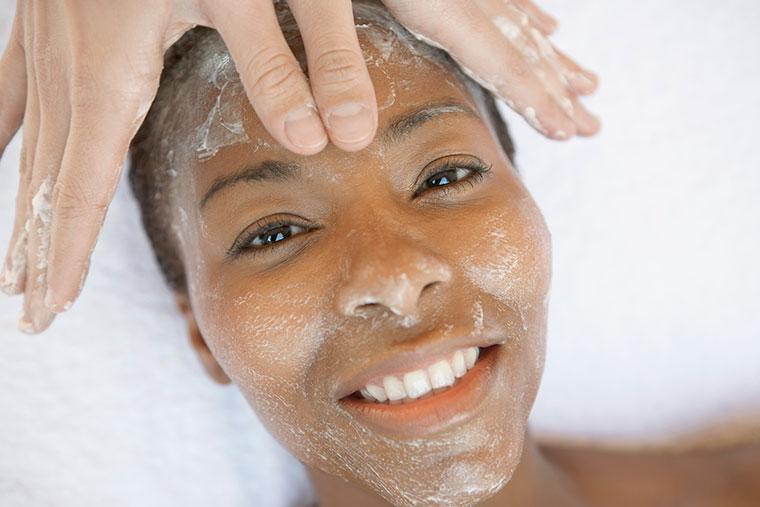Everything You Want to Know (and Stuff You Don’t!) About the Vampire Facial
The PRP facial involves getting your blood drawn and then spun to isolate the plasma from the red and white blood cells. Once that's done, the liquid is then microneedled into skin. The benefits are wide-ranging and include everything from decreasing the appearance of fine lines, zapping acne scars and hyperpigmentation, to stimulating collagen.
"The plasma's the growth factor—so basically that's like the fertilizer for the lawn." —Nurse Gigi
"The plasma's the growth factor of blood—so basically that's like the fertilizer for the lawn," says Genevieve Vielbig, RN, BSN, CANS, AKA Nurse Gigi, the certified aesthetic nurse specialist who gave me the treatment that night in downtown New York. "It's the best part of your blood. So you're microneedling your face and making all of these micro-channels by digging holes into the skin, that way the PRP can penetrate into the skin and help to heal." Originally, using this magical part of your blood was injected into torn ligaments in injured athletes to speed up healing, she explains—which makes it sound like it'll do wonders to my face.
Besides that, plasma is totally safe. "Using a patient’s own plasma is ideal because it’s natural, plentiful, and they have no allergies to it since their body produces it," says Norman Rowe, MD, a New Jersey board-certified plastic surgeon. "It works by attracting stem cells to the area that they're used. In the face, stem cells make new, more youthful looking skin because they become new collagen and elastin." So yeah...sign me up.

Keep scrolling for what it's really like to get a PRP facial.
To start the PRP facial, Nurse Gigi slathers my face with medical-strength numbing cream the moment I walk in. Nothing happens until that cream sits on my skin for 45 minutes prior to the facial, during which time my face becomes extremely numb. Following this, Nurse Gigi takes a significant amount of blood from my arm (to ensure we get enough plasma to use). "You make a lot of plasma," she says after she puts the vials in a coagulator to spin for 10 minutes to get the skin-boosting plasma out. "That means you're hydrated." Feeling smug, I lean back and await the treatment as she whips out the microneedling device and switches it on.

{{post.sponsorText}}
Then she starts going for it on my forehead—she says it's usually the most painful since that's where your skin's the thinnest. I'm pretty shocked that the sensation isn't more intense, though I do feel some uncomfortableness—kind of like there's an unpleasant metal sandpaper thing going over my head. It gets much easier after this, as she proceeds to run it over my cheeks, chin, and nose. Really it's just a slight sensation of something penetrating my skin. I think I said ouch only once, when she microneedled my jawline ("It'll hurt on places the numbing cream missed," says Nurse Gigi). Fair.
After going over each section of my face, she applies my plasma to my skin, which feels like a thick, viscous serum. The entire process itself (not counting the numbing or coagulation time) takes about 15 to 20 minutes. And yes, it is a bloody mess—I realize this as Nurse Gigi holds a mirror to my face when she's finished. I don't look like I'm starring in a horror film, but there's this overall redness that gives the look of being lightly covered in blood (it's from the needling—because the plasma itself is clear).
Nurse Gigi cleans it up and gives me post-treatment instructions (which there are a good number of). You're not to sweat or use any skin-care or makeup products for 48 hours, and avoid sun exposure for as long as possible (three days minimum). In other words: Your skin's super vulnerable for a couple of days. And it's clear—there is some downtime to the treatment. I leave the salon with a significantly red face, which of course is normal given that a bunch of tiny holes were pricked in my complexion.
"You'll start to have shedding or exfoliating in three to four days, and that'll be where you start to see the benefit," Nurse Gigi explains. "In about a week or week and a half, you'll see that your skin's glowing." I'm now on day three and while there's a tiny bit of lingering redness, my skin looks really clear and back to normal...only already a bit better: My post-inflammatory hyperpigmentation seems to have lightened up.
While I'm very pleased so far with the glowy benefits, Nurse Gigi says that the results are cumulative and build on the results of the previous treatment. And while the vampire facial treatment may sound really out there and freaky, it doesn't feel like it when you do it. With these results, consider me a bloody fan.
I've also used a moisturizer made out of my own blood before, which also had good results. For something more low-key, try one of these dry skin moisturizers.
Loading More Posts...